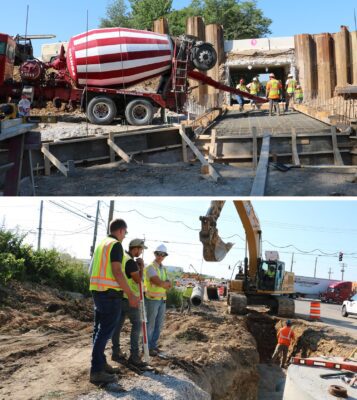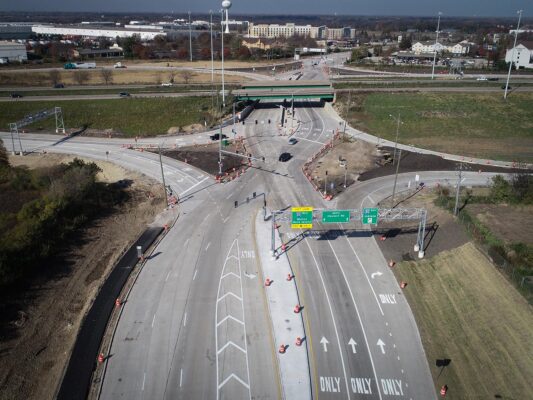
An award winner and a first for Illinois, the Houbolt Road at I-80 Diverging Diamond Interchange was completed in December 2023. With Brent Giesen, P.E., as Resident Engineer, Civitech provided Phase III Construction Engineering services on this large and complex project.
The Houbolt Road Interchange with I-80 is a major connection between the interstate and a busy section of southwest Joliet. The Houbolt Road corridor is home to Joliet Junior College, Joliet Regional Airport, Hollywood Casino, and major trucking/railroad centers to the south, including an intermodal center that is considered the nation’s largest inland port. Many industrial park businesses, the Forest Preserve District of Will County, and residential neighborhoods are also part of this heavily traveled corridor. These combined land uses result in massive annual freight activities and daily truck movements as well as a multitude of everyday motorists. 
The DDI project was in conjunction with a 1.5-mile extension of Houbolt Road that carries it across the Des Plaines River. This connection provides a faster and more direct route for the trucking to move between I-80 and the intermodal yards as well as all other vehicular traffic. As a result, the I-80 and Houbolt Road Interchange will continue to see significantly increased traffic, and the DDI configuration was necessary to accommodate traffic as it accesses I-80.
When asked what he most enjoyed about the complex project, Brent said, It was rewarding to work on an integral piece of such a huge undertaking, as the project included a new river bridge, completely revamped interchange, and extensive forthcoming work on I-80. This area has undergone so much positive change and will continue to do so with the planned I-80 improvements.
Diverging Diamond Interchanges are designed to improve mobility and safety while being cost effective. DDI’s are similar to conventional diamond interchanges with the right turn functions. The difference is managing the left turning traffic with a crossover which diverges traffic from the right side of the road to the left so that left turns do not cross on-coming traffic. 
The crossover pattern created one very challenging maintenance of traffic component for the Phase III team. When asked what kept him up at night, Brent responded, Envisioning how to make the final traffic switch.
DDI’s are a good design alternative if intersections, like Houbolt Road at I-80 have heavy volumes of left turns onto the freeway and have a need for increased capacity within the confines of existing roadway or bridge footprints. The Houbolt Road DDI design provided an efficient and cost effective construction by fitting the interchange within the footprint of the existing bridges. A limited number of DDI designs have been implemented in Illinois in the past decade. However, this project is the only DDI in Illinois with the unique design of the cross street (Houbolt Road) passing under the expressway (I-80). 
The Houbolt Road Improvement encompasses a wide array of structural and roadway items. Micro-pile supported retaining walls provided the required space under the I-80 bridges for the diverging diamond at grade lanes. Overhead clearance restrictions caused by the I-80 bridges were accommodated with the use of micro-piles which can be installed without the need for tall cranes.
Two structures over Rock Run Creek and the I&M Canal along with a pedestrian underpass carry the new lanes over those existing crossings. Two MSE retaining walls solved the right of way restrictions surrounding the widened cross sectional footprint near the I&M Canal.
The construction included a number of additional considerations. The at-grade crossing of the CSX Railroad had to be reconstructed to accommodate the wider cross section. Tight width restrictions for the DDI were overcome by placing an existing pedestrian path in the median under the I-80 bridges. A drainage storage basin was created as part of the improvements, and the excavated material was then used for raising Houbolt as it approaches US 6. Construction coordination also included the installation of five interconnected traffic signals along with roadway, interchange, and underpass lighting improvements.

Most rewarding, however, is a successful project outcome. Brent points out that new businesses and developments are already underway and increased/undelayed traffic from the corridor improvements are testimonies to the success of the project. Also, he noted that he’s encountered the occasional comment from a member of the general public who recognizes the big picture, understands the need for infrastructure improvements, and is grateful for the time, effort, and funding that went into this project for the benefit of their community.
